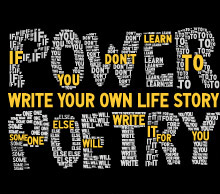
"Claudia Rankine's formally inventive poems investigate many kinds of boundaries: the unsettled territory between poetry and prose, between the word and the visual image, between what it's like to be a subject and the ways we're defined from outside by skin color, economics, and global corporate culture. This fearless poet extends American poetry in invigorating new directions. — Mark Doty
Claudia Rankine's poetry shines a blazing light on injustice in twenty-first century America. Born in Kingston, Jamaica in 1963, Rankine went to undergrad at Williams College, then earned her MFA from Columbia. Her groundbreaking collection Citizen: An American Lyric was the first poetry book to be a New York Times Bestseller in Nonfiction. Citizen uses poetry, prose, and photography to explore the intersections of race, gender, and class in today's world.
Wish you could write like Claudia Rankine? Keep reading to find out more. Then post your new piece on Power Poetry so you can inspire others with your poetry!
Learn How to Write Like Claudia Rankine
- Tell Your Story. In her poem from Citizen, "I" Rankine uses her personal experience to illustrate a broader struggle. You can feel her anger and her frustration bleed through the lines. Recounting a lunch she had with a stranger, Rankine describes how the other woman went on a tirade against "affirmative action or minority something — she is not sure what they are calling it these days and weren't they supposed to get rid of it?" Rankine uses this story to demonstrate how the history of race can come between people, making interpersonal connections "fragile, tenuous, subject to any transgression of your historical self." Try writing a poem about a frustrating experience in your life. Be as specific as possible by using imagery. Make readers feel as if they're a part of your story.
- Curate Your Story. Rankine cuts her narrative down to its essential parts in this excerpt from her poem "Don't Let Me Be Lonely." Each word is necessary; each line connects to the next. Rankine uses her experience at airport security to heighten the sense that traveling to the nursing home is like traveling to another country. But she doesn't describe any more of the journey, or overly belabor the point. Her poetry flows together seamlessly, like a train of thought. Think carefully about what you include in your poetry. Consider what each piece of information does for the piece overall and what meaning it creates. After you finish a poem, go back to it after a day or so and cut any lines that aren't pulling their weight.
- Don't Be Afraid to Cross Genres. Rankine's poem "Don't Let Me Be Lonely: Mahalia Jackson is a genius" is unique - it doesn't look like a poem, does it? Yet somehow we understand it to be poetry. This type of poetry is called prose poetry. Prose poetry doesn't have line breaks but it retains the feeling of poetry though the use of poetic devices. Rankine intersperses prose poetry, verse, and even some poetic essays in her writing to tell her story. Try writing a prose poem. If you're having trouble getting started, find an old poem and take out the line breaks. See how this new form changes the piece, then make any edits you need to make it work as a prose poem.
- Use Visual Images. In both "Citizen" and "Don't Let Me Be Lonely," Rankine pairs her words with relevant images. In the first chapter of "Citizen," she inserts Michael David Murphy's photo entitled "Jim Crow Road." Rankine states that the visual elements in her work are there where "silence was needed, but [she] wasn't interested in making the silence feel empty or effortless the way a blank page would." Think about how you might use photographs or other images to complement your own work. Check out how the visual arts interact with poetry with Power Poetry's 5 Tips for Writing Ekphrastic Poetry.
- Collect Your Work. Each of Rankine's poems is powerful on its own, but together they create something greater. Go through your past writing and see if there are any themes running through your work. Experiment with connecting multiple poems to create a larger narrative. See if you can collect your own chapbook, or piece together an epic narrative from shorter poems. Your life story is one worth telling.
Looking for more poets to read? Check out Power Poetry's 7 Top Young Poets to Watch in 2019.
